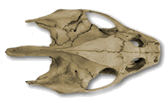Tetrapods: More on
Morphology
Tetrapods have four limbs.

Tetrapod means "four feet," and all tetrapods -- except for highly
modified forms, such as snakes -- have four limbs with the same basic
structure. These limbs are most commonly used for locomotion -- crawling,
walking, running, flying, or swimming -- and are modified accordingly, but
all tetrapod limbs share a common basic structure. Both the forelimb and the hindlimb
have one long bone that
attaches to the body at one end and to two long bones at the other end.
 The two long bones join a group of smaller carpal bones (in the
forelimb) or tarsal bones (in the hindlimb) which form the "hand" (or
manus)
and "foot" (or pes) along with the digits (fingers and toes). The oldest tetrapods
had seven or eight digits on each limb; the ancestral pattern for living
tetrapods is five digits on each limb (such as the five fingers and toes of
humans). However, there are a huge number of ways in which this basic pattern
has been modified through evolution. To give a very few examples: horses
have lost all but one of their digits; birds have lost or fused together
their tarsal bones, carpal bones, and forelimb digits; whales and dolphins
have rudimentary internal hindlimbs; most snakes have lost all trace of
limbs. The two long bones join a group of smaller carpal bones (in the
forelimb) or tarsal bones (in the hindlimb) which form the "hand" (or
manus)
and "foot" (or pes) along with the digits (fingers and toes). The oldest tetrapods
had seven or eight digits on each limb; the ancestral pattern for living
tetrapods is five digits on each limb (such as the five fingers and toes of
humans). However, there are a huge number of ways in which this basic pattern
has been modified through evolution. To give a very few examples: horses
have lost all but one of their digits; birds have lost or fused together
their tarsal bones, carpal bones, and forelimb digits; whales and dolphins
have rudimentary internal hindlimbs; most snakes have lost all trace of
limbs.
The tetrapod skull is a useful feature for classification.
 |
One of the most useful features in classifying tetrapods is the skull,
a collection of bones which surrounds the brain, and includes the jaw. The
structure and arrangement of the bones in the skull is what gives the major
groups of amniote tetrapods their names. The Anapsida,
Diapsida,
and
Synapsida
are defined by the number of openings on each side of the
skull: zero, two, and one, respectively.
|
This turtle fossil is an example of an Anapsid skull. Notice how there are no holes on the back of the skull behind the large eye holes.
|
Harris' Hawk photo courtesy Gerald and Buff Corsi © California Academy of Sciences.
Merriam's Kangaroo Rat photo courtesy Dr. Lloyd Glenn Ingles © California Academy of Sciences.
Pico Blanco Robber Frog photo courtesy © Andrew J. Crawford.
Green Sea Turtle photo courtesy Caroline Kopp © California Academy of Sciences.
Pronghorn Antelope photo courtesy Glenn and Martha Vargas © California Academy of Sciences.
Turtle skull fossil photo © UCMP.



|





 The two long bones join a group of smaller carpal bones (in the
forelimb) or tarsal bones (in the hindlimb) which form the "hand" (or
manus)
and "foot" (or pes) along with the digits (fingers and toes). The oldest tetrapods
had seven or eight digits on each limb; the ancestral pattern for living
tetrapods is five digits on each limb (such as the five fingers and toes of
humans). However, there are a huge number of ways in which this basic pattern
has been modified through evolution. To give a very few examples: horses
have lost all but one of their digits; birds have lost or fused together
their tarsal bones, carpal bones, and forelimb digits; whales and dolphins
have rudimentary internal hindlimbs; most snakes have lost all trace of
limbs.
The two long bones join a group of smaller carpal bones (in the
forelimb) or tarsal bones (in the hindlimb) which form the "hand" (or
manus)
and "foot" (or pes) along with the digits (fingers and toes). The oldest tetrapods
had seven or eight digits on each limb; the ancestral pattern for living
tetrapods is five digits on each limb (such as the five fingers and toes of
humans). However, there are a huge number of ways in which this basic pattern
has been modified through evolution. To give a very few examples: horses
have lost all but one of their digits; birds have lost or fused together
their tarsal bones, carpal bones, and forelimb digits; whales and dolphins
have rudimentary internal hindlimbs; most snakes have lost all trace of
limbs.



